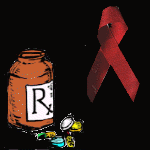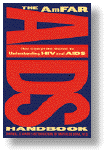 |


|
|
Developed by Dr. Jack H. Nunberg, AmFAR Grantee Findings in Science Magazine —January 15 Issue |
|
Compiled By GayToday
 New York City. January 15--The American Foundation for AIDS Research (AmFAR) has
announced that a recipient of one of last year's AmFAR grants targeted for
AIDS vaccine research has reported a breakthrough in the development of a
possible AIDS vaccine, which was tested in mice. The findings are being
published in today's ( January 15) issue of the journal Science.
New York City. January 15--The American Foundation for AIDS Research (AmFAR) has
announced that a recipient of one of last year's AmFAR grants targeted for
AIDS vaccine research has reported a breakthrough in the development of a
possible AIDS vaccine, which was tested in mice. The findings are being
published in today's ( January 15) issue of the journal Science.
The researcher is Dr. Jack H. Nunberg of the University of Montana in Missoula. Last year, Dr. Nunberg was one of eleven scientists nationwide who were recipients of AmFAR's vaccine grants, which totaled more than $1.1 million. Nunberg's AmFAR grant allowed him to develop the potential HIV vaccine.
"I'm very grateful for AmFAR's foresight in financing this novel study," he states. "When I initially applied for funding, we had little more than an attractive hypothesis, and AmFAR had the courage and imagination to pursue research that is now having very promising results. We believe our discovery opens the door to a new approach in vaccine development and will one day lead to an effective HIV vaccine." "Jack Nunberg has some of the most interesting data I've seen for an HIV vaccine approach," said Dr. Robert Gallo, Director of the Institute of Human Virology at the University of Maryland. "I must admit, an applicant from our institute had similar ideas which were rejected in his federal grant application as not do-able. I have heard it was similar for Dr. Nunberg. Thankfully AmFAR supported his research. His results raise new hopes for HIV vaccines." "I heard Dr. Nunberg present the work at the Keystone Conference and it was the talk of the meeting," said Nobel laureate Dr. David Baltimore, President, California Institute of Environment/ Technology in Pasadena. "He has brought a badly-needed new concept to how anti-HIV antibodies can be induced by a vaccine. It is a credit to AmFAR that it dedicated funding to innovative concepts in vaccine research and particularly that it recognized the potential in Nunberg's work." Nunberg constructed a fusion-competent vaccine in which HIV coat proteins are joined to the HIV receptor complex (CD4 + co-receptor). The source of the AIDS virus envelope used for the Nunberg immunization was an HIV-infected young man in Amsterdam. The vaccine was injected into mice, who were then able to fight off the virus. Blood samples from the immunized mice were tested for their ability to "neutralize" or destroy HIV obtained from patients in the United States, Africa, Thailand and India. Remarkably -- and in contrast to every other vaccine candidate thus far tested in animals or humans -- the blood of these mice killed 24 out of 25 of the AIDS virus isolates tested. The mice used in the development of this vaccine came from the laboratory of another prominent research scientist who is also an AmFAR grantee: Dr. Daniel Littman, Professor of Pathology and Microbiology at New York University Medical Center in New York City. Last year, AmFAR awarded Dr. Littman a grant to develop a mouse model in which potential HIV vaccines can be efficiently tested. "The development of a preventive anti-AIDS vaccine is essential to stopping the worldwide epidemic of HIV," said Dr. Mathilde Krim, Founding Co-Chair and Chairman of the Board of AmFAR.
 "Our mission here at AmFAR
is to support those scientists whose research is both innovative and
grounded in solid scientific hypotheses. We are proud of our role in Dr.
Nunberg's breakthrough, one that brings us closer to a world without
AIDS."
"Our mission here at AmFAR
is to support those scientists whose research is both innovative and
grounded in solid scientific hypotheses. We are proud of our role in Dr.
Nunberg's breakthrough, one that brings us closer to a world without
AIDS."
All proposals submitted to AmFAR are peer-reviewed, and funding follows recommendations by AmFAR's Scientific Advisory Committee. For the proposals received from Drs. Nunberg and Littman, the reviewers were experts in the fields of vaccine research and immunology. Since 1985, AmFAR has invested over $150 million in support for its programs, primarily through grants to more than 1,700 research teams. |

© 1997-98 BEI